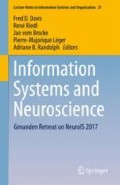Abstract
Watching a film in a movie theater can be an immersive experience, but to what extent does the experience differ when the moviegoer is using a vibro-kinetic seat, i.e., a seat providing motion and vibration feedback synchronized with the movie scenes? This paper seeks to measure the effect of a multi-sensory cinema experience from a psychophysiological standpoint. Using electroencephalography, galvanic skin response, heart rate, and facial micro-expression measures, this study compares the difference between two movie viewing experiences, i.e. one without movement and one with artistically enhanced vibro-kinetic feedback. Results of a within-subject experiment suggest that there are significant differences in psychophysiological states of users. Users exhibit more positive emotions, greater arousal, and more cognitive immersion in the vibro-kinetic condition. Therefore, multi-sensory stimulation, in the context of cinema, appears to produce an enhanced experience for spectators.
Access this chapter
Tax calculation will be finalised at checkout
Purchases are for personal use only
References
Galloso, I., Palacios, J.F., Feijoo, C., Santamaria, A.: On the influence of individual characteristics and personality traits on the user experience with multi-sensorial media: an experimental insight. Multimedia Tools Appl. 1–44 (2016)
Jackman, A.H.: 3-D cinema: immersive media technology. GeoJournal 80(6), 853–866 (2015)
McMahan, A.: Immersion, engagement and presence. In: The Video Game, Theory Reader, vol. 67 (2003)
Recuber, T.: Immersion cinema: the rationalization and reenchantment of cinematic space. Space Cult. 10(3), 315–330 (2007)
Visch, V.T., Tan, E.S., Molenaar, D.: The emotional and cognitive effect of immersion in film viewing. Cogn. Emot. 24(8), 1439–1445 (2010)
Riedl, R., Léger, P.M.: Fundamentals of NeuroIS. Springer, Berlin (2016)
Kaye, J.J.: Making Scents: aromatic output for HCI. Interactions 11(1), 48–61 (2004)
Carù, A., Cova, B.: How to facilitate immersion in a consumption experience: appropriation operations and service elements. J. Consum. Behav. 5(1), 4–14 (2006)
Waltl, M., Timmerer, C., Hellwagner, H.: Improving the quality of multimedia experience through sensory effects. In: 2010 Second International Workshop on Quality of Multimedia Experience (QoMEX). IEEE (2010)
Abadi, M.K., Staiano, J., Cappelletti, A., Zancanaro, M., Sebe, N.: Multimodal engagement classification for affective cinema. In: 2013 Humaine Association Conference on Affective Computing and Intelligent Interaction (ACII). IEEE. (2013)
Bos, M.G.N., Jentgens, P., Beckers, T., Kindt, M.: Psychophysiological response patterns to affective film stimuli. PLoS ONE 8(4), e62661 (2013)
Fleureau, J., Guillotel, P., Orlac, I.: Affective benchmarking of movies based on the physiological responses of a real audience. In: 2013 Humaine Association Conference on Affective Computing and Intelligent Interaction (ACII). IEEE (2013)
Lang, P.J., Greenwald, M.K., Bradley, M.M., Hamm, A.O.: Looking at pictures: affective, facial, visceral, and behavioral reactions. Psychophysiology 30, 261–273 (1993)
Rothwell, S., Lehane, B., Chan, C.H., Smeaton, A.F., O’Connor, N.E., Jones, G.J.F., Diamond D.: The CDVPlex biometric cinema: Sensing physiological responses to emotional stimuli in film. In: The 4th International Conference on Pervasive Computing (2006)
Pope, A.T., Bogart, E.H., Bartolome, D.S.: Biocybernetic system evaluates indices of operator engagement in automated task. Biol. Psychol. 40(1), 187–195 (1995)
Charland, P., Léger, P.M., Sénécal, S., Courtemanche, F., Mercier, J., Skelling, Y., Labonté-Lemoyne, E.: Assessing the multiple dimensions of engagement to characterize learning: a neurophysiological perspective. In JoVE J. Visualized Exp. 101, (2015)
Léger, P.M., Sénecal, S., Courtemanche, F., Ortiz de Guinea, A., Titah, R., Fredette, M., Labonte-LeMoyne, E.: Precision is in the eye of the beholder: Application of eye fixation-related potentials to information systems research. J. Assoc. Inf. Syst. 15(10), 651 (2014)
Léger, P.M., Davis, F.D., Cronan, T.P., Perret, J.: Neurophysiological correlates of cognitive absorption in an enactive training context. Comput. Hum. Behav. 34, 273–283 (2014)
de OrtizGuinea, A., Titah, R., Léger, P.M.: Measure for measure: A two study multi-trait multi-method investigation of construct validity in IS research. Comput. Hum. Behav. 29(3), 833–844 (2013)
Baars, B.J., Gage, N.M.: Fundamentals of cognitive neuroscience: A beginner’s guide. Academic Press (2012)
Author information
Authors and Affiliations
Corresponding author
Editor information
Editors and Affiliations
Rights and permissions
Copyright information
© 2018 Springer International Publishing AG
About this paper
Cite this paper
Pauna, H. et al. (2018). The Psychophysiological Effect of a Vibro-Kinetic Movie Experience: The Case of the D-BOX Movie Seat. In: Davis, F., Riedl, R., vom Brocke, J., Léger, PM., Randolph, A. (eds) Information Systems and Neuroscience. Lecture Notes in Information Systems and Organisation, vol 25. Springer, Cham. https://doi.org/10.1007/978-3-319-67431-5_1
Download citation
DOI: https://doi.org/10.1007/978-3-319-67431-5_1
Published:
Publisher Name: Springer, Cham
Print ISBN: 978-3-319-67430-8
Online ISBN: 978-3-319-67431-5
eBook Packages: Business and ManagementBusiness and Management (R0)

